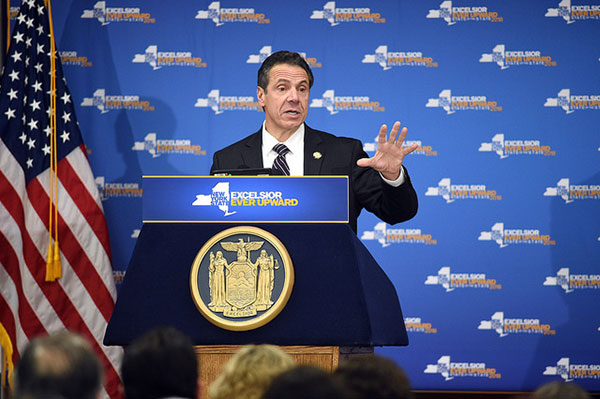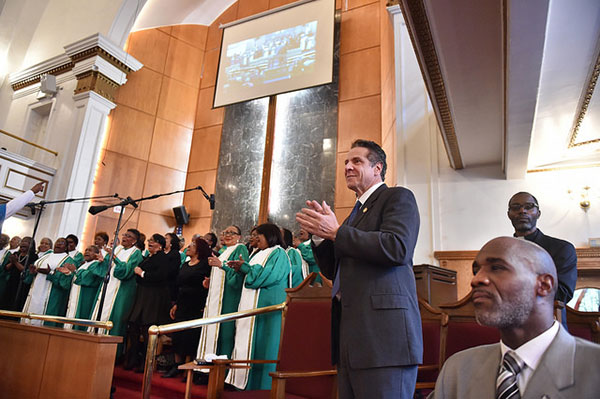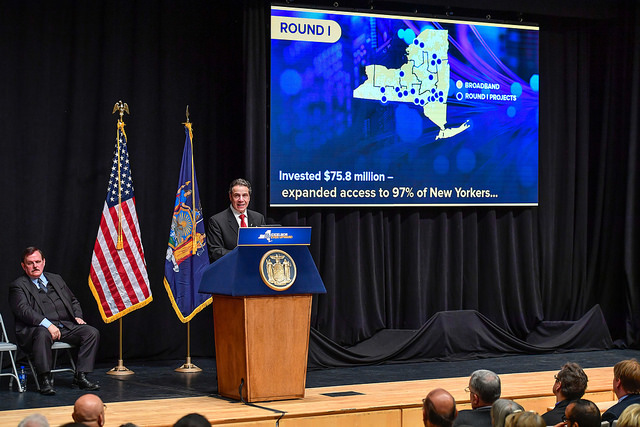The Problem with Cuomo's Payroll Tax

Gov. Cuomo (photo: Kevin P. Coughlin/Governor's Office)
Other high-tax states have considered it, but New York just became the first state to actually do it: revamp its tax code to mitigate the new $10,000 federal cap on deducting state and local taxes (SALT). As part of the new state budget, the Legislature enacted the Governor’s plan for a new voluntary 5% payroll tax New York employers can opt into. It would exempt their employees from paying state income tax, and thereby help keep them below the federal cap.
But the new payroll tax has many detractors, including the New York Business Council, which called many of its provisions unworkable, the New York chapter of the National Federation of Independent Business, which said its members feared it sets the stage for a tax hike on small businesses, and experts convened by the Manhattan Institute, who point out it will penalize commuters from New Jersey and Connecticut. Many predict that only a few small, well-heeled firms will be able to take advantage of it, and many worry the IRS will simply close down the loophole Cuomo just opened.
These objections are all well-founded, but there’s a bigger, more fundamental problem with the scheme: payroll taxes hurt job growth.
In theory, employers who opt into the tax will be made whole because they can pass the cost onto workers by lowering wages 5%. Workers will be made whole since they wouldn’t pay state income tax, and it would help them stay below the federal deductibility limit on SALT. All together, it’s supposed to be a wash.
But in practice it doesn’t work that way. Wages are “sticky” and notoriously hard to pull back once workers attain a certain number on their pay stubs. In a large workforce, getting all employees to accept a nominal 5% pay cut will be a nightmare. Even for small firms with few workers, existing contracts, minimum wage, and competition for sought-after employees will bedevil an across-the-board pay cut. As the New York State Department of Taxation and Finance warned, if employers can't pass the full tax bill onto employees, their net labor costs go up. That drives hiring down.
The new payroll tax doesn't exist in a vacuum, but as part of the larger tax environment, which includes high federal payroll taxes that already inhibit job and economic growth.
They are the biggest taxes a large majority of Americans pay, and the most regressive, squeezing workers who don’t earn enough money to pay income tax or benefit from income tax cuts. Paying payroll taxes lowers workers’ earnings and curtails consumer spending and economic growth. Even so, Congress refused to cut them when it cut federal income and corporate taxes (though Senators Lee and Rubio tried).
Federal payroll taxes also distort relative prices of labor versus. non-labor inputs to business (energy, materials and land) making hiring artificially expensive and consumption artificially cheap. The distortion amounts to over $1 trillion a year (the amount federal payroll taxes raise), or about 5.4% of GDP.
That’s a big, structural drag on jobs that has resulted in a big, structural (though largely hidden) overhang of joblessness. There’s a shocking fact hiding in plain sight in the rosy Bureau of Labor Statistics unemployment charts: out of 257 million non-institutionalized American adults, over 100 million don’t have jobs.
Of those, 95 million aren’t counted as “unemployed;” they’re just considered outside the workforce. That’s legitimate for people who are retired, or who aren’t able or don’t chose to work. But many tens of millions of them, including millions in New York, aren’t working because they lack job opportunity, due in significant part to the corrosive effects of payroll taxation.
To whatever extent firms adopt it, New York's new payroll tax will only compound these problems.
Instead, payroll tax should be cut to boost jobs, both at the federal and state levels, like Colorado did. Since 2008, Colorado’s Job Growth Tax Credit has refunded state payroll tax for job creating businesses. It brought thousands of high-quality jobs to the state and grew its tax base.
Revenue lost from cutting payroll taxes could be replaced with non-labor taxes on resource consumption, waste, inefficiency and pollution. That’s a tax reform approach known as payroll tax shifting. According to the bipartisan group Get America Working!, which I advise, it would reverse payroll tax’s longstanding distortions, roughly doubling the job-creating effects of cutting payroll taxes alone, creating tens of millions of jobs nationwide. In New York, non-labor taxes on consumption we want to limit could raise state revenues and fund tax relief for individuals hurt by the federal deductibility cap.
Which non-labor taxes exactly is a topic for the next budget debate. But there is no lack of options. How about getting serious about collecting the 20% of New York sales tax that still goes unpaid? Or adopting real congestion pricing instead of the quarter-measure in this year’s budget? Or considering the state carbon tax designed by NYRenews that would raise $7 billion annually, help meet New York’s climate goals, and stimulate renewables sector jobs?
New York’s new payroll tax is aimed at downstate, high-paying firms. It might or might not help a narrow band of them at the cost of undercutting job growth. But New York needs a tax policy that boosts employment statewide, including upstate. That’s why we need a tax overhaul that takes the burden off employment and puts it on harmful consumption, waste and pollution.
***
Stephen Kent is president of the public interest PR practice KentCom LLC and consults for the bipartisan employment policy group Get America Working!
***
Have an op-ed idea or submission for Gotham Gazette? Email This email address is being protected from spambots. You need JavaScript enabled to view it.
New York Justice Delayed Is New York Justice Denied

Gov. Cuomo at church (Kevin P. Coughlin/Office of Governor Andrew M. Cuomo)
It has been nearly three years since Kalief Browder tragically ended his own life after being caged, abused, and tortured on Rikers Island. Elected officials promised us that his story would be a turning point and that New York would fundamentally transform a criminal justice system designed to criminalize low-income black and brown New Yorkers and then place a bounty, through the money bail system, on our freedom. With another new state budget now passed in Albany, it is clear state leaders are not going to make good on those promises and New York will continue to keep people locked in cages because they are too poor to pay bail.
I cannot imagine what Kalief must have felt while trapped in a cage, spending much of his time in solitary confinement, facing abuse from the guards and other incarcerated youth -- only there because he could not afford bail. As a young black person, growing up in Brooklyn, I can relate to how Kalief must have felt that night; his future was permanently disrupted. I have been out in my neighborhood, just enjoying myself, or hanging out with friends, only to have the NYPD initiate an interaction that reminds black youth we cannot afford to be care-free when the criminal justice system surveils, restricts, and criminalizes our very existence.
That is why I organize with youth across Brooklyn and New York City to end racist and biased policies and practices throughout the criminal justice system. It is why last week, I traveled three hours to Albany to join civil rights organizations, public defenders, community organizations, and NFL player DeMario Davis (formerly of the New York Jets), to demand New York legislators pass bail reform that will completely eliminate wealth-based detention, significantly reduce the number of New Yorkers caged before their trial, reduce racial disparities, end profiteering in pre-trial services, and does not increase the likelihood that people will be detected, detained or deported by federal Immigration and Customs Enforcement (ICE).
In Governor Cuomo’s State of the State speech he made promises to reshape New York’s bail and pre-trial detention that will “will transform our criminal justice system by removing critical barriers, reaffirming our beliefs in fairness, opportunity and dignity, and continue our historic progress toward a more equal society for all." He did not follow through by passing reforms that would have made positive change.
And, unfortunately, when I studied his proposals, it became clear some parts could actually bring reform in the wrong direction. If passed, the governor’s proposal would increase the number of New Yorkers who are detained before trial without the possibility of release, give prosecutors the power to hold New Yorkers before trial, expand the use of electronic monitoring and house arrests, and pass the costs of pre-trial services on to people awaiting their trial. It isn’t progress if we extend mass incarceration into our homes and communities through ankle bracelets and house arrests and then charge poor people for the cost of their release before trial.
A recent report from the New York Civil Liberties Union found that black New Yorkers are twice as likely as white New Yorkers to spend at least one night in custody on bail, and more than 90,000 New Yorkers spent a day or longer in custody on bail between 2010 and 2014. Kalief Browder was arrested in 2010. Eight years after his arrest and three years after his death, the turning point we were all promised seems farther and farther away.
With Governor Cuomo now celebrating the new budget and the state Legislature on vacation; and as we hit the 50th anniversary of the murder of Dr. Martin Luther King, Jr., we should all remind our elected officials that justice delayed is justice denied.
***
Nicshel Samedi is Youth Leader, Make The Road New York. On Twitter @MaketheRoadNY.
***
Have an op-ed idea or submission for Gotham Gazette? Email This email address is being protected from spambots. You need JavaScript enabled to view it.
State Budget Includes Unprecedented $175 Million to Invest in Skills - Now What?

Gov. Cuomo (photo: The Governor's Office)
New research released last month by JobsFirstNYC and the Community Service Society found that more than 136,000 young adults 18-24 years old in New York City are not working and not enrolled in school. And despite increased enrollment, equity gaps in college completion have widened in New York City. Meanwhile, all of the employment gains for members of this age group over the last five years has been in low-wage, part-time work. But New York City’s young adults are not the only group facing barriers to enter and succeed in an increasingly more skilled labor market, as more than 40 percent of residents across the state only have a high school diploma or less in a time when employers are crying out for more trained workers.
Recognizing the urgent need to invest in human capital, Governor Cuomo put forward a promising vision that will put the state on a path to realizing the full potential of all New Yorkers and the Legislature worked with him to include it in a final budget deal (read Governor Cuomo’s Workforce Investment Plan is a Promising Start for overview of the governor’s original proposal). This is a victory for New Yorkers. The governor and the state Legislature should be applauded.
Included in the final New York State budget for the fiscal year that began April 1 is an unprecedented $175 million for workforce development, which will flow through a Consolidated Funding Application (CFA) process likely to begin as early as this spring. The final deal is not all that different from what Governor Cuomo proposed back in January and gives a great deal of autonomy to him to design and manage the CFA process and decide how best to allocate resources regionally. Because of the flexibility the executive chamber has, it’s safe to assume that the resources will be connected in some way to (and potentially managed out of) Empire State Development and the Regional Economic Development Councils, as was outlined in the governor’s original proposal. Wherever the CFA process ends up, the $175 million must be regionally-targeted, support multi-year strategies, and be available on a rolling basis.
The only real mandate by the Legislature included in the final budget deal is to work with the State Workforce Investment Board and the agencies that currently administer workforce development programs (New York Department of Labor, SUNY, CUNY, etc.). The legislation states: “Services and expenses for workforce development shall be administered in consultation with the state workforce investment board and state agencies responsible for administration of workforce development programs.”
In addition to establishing a CFA process to allocate the $175 million across the state, the governor also put forward three other workforce development proposals that were not part of adopted budget legislation. This includes establishing a New York State Office of Workforce Development, building a state-of-the-art data analytics infrastructure modeled after Monroe Community College’s, and creating a one-stop-shop online platform for job-seekers and employers. The good news for these initiatives is that the governor has the administrative authority to do them without the need to pass legislation.
The Legislature’s mandate to work with all the agencies that currently provide workforce development and training programs as well as to work in consultation with the state’s Workforce Investment Board to coordinate the CFA process should be treated as the first task of the soon-to-be-created New York State Office of Workforce Development. With $175 million of workforce development resources secured, this new office has a unique opportunity to create a responsive, 21st century workforce unleashing the full economic power of the state.
To realize this vision, Governor Cuomo must also charge the Office of Workforce Development to create a more integrated workforce development system that ensures there is dedicated state-funded revenue stream year-to-year and braids together existing funding streams for programs (TANF, SNAP E&T, WIOA, etc.) with similar goals, as well as establishes a shared framework for measuring outcomes. Additionally, this office must work across government to align the education, human services, economic, and workforce development systems. In doing so, the state will need to invest in demand-driven innovative ideas and partnerships to create a structurally adaptable and responsive workforce development system. Finally, this newly created office must make shared outcomes, accountability, and transparency the ‘new normal.’
Fortunately, Governor Cuomo and the soon-to-be named Director of the Office of Workforce Development does not need to do this alone. The Invest In Skills NY initiative—a diverse statewide coalition of employers, training providers, intermediaries, higher education institutions, professional and trade associations, young adult groups, and many others who make-up the workforce development system are ready to work to bring New York State’s labor force into the 21st century.
***
Kevin Stump is vice president of Policy, Communications, and In-School Practice at JobsFirstNYC and co-chair of the Invest In Skills NY Campaign. On Twitter @KevinStump and @JobsFirstNYC; #InvestInSkillsNY.




